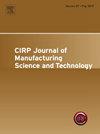Effect of workpiece vibration on dynamic cutting force in thin-walled plates trimming
IF 5.4
2区 工程技术
Q2 ENGINEERING, MANUFACTURING
CIRP Journal of Manufacturing Science and Technology
Pub Date : 2025-06-06
DOI:10.1016/j.cirpj.2025.05.013
引用次数: 0
Abstract
In trimming of long overhanging thin-walled plates, we observed that the cutting force along the tool axis can be bidirectional rather than unidirectional like milling of short and stiff overhanging plates. This experimental phenomenon cannot be explained by standard oblique cutting force models. Accordingly, this study systematically investigated the interaction mechanism between the tool and the workpiece during trimming. It turned out that vibration velocity and displacement of the workpiece have non-ignorable effects on the direction of cutting velocity, engagement position between tool and workpiece, resulting in state-dependent inclination angle, instantaneous rotation angle and time delay. Consequently, a dynamic cutting force model that incorporates workpiece vibration-based modulation effects was developed, which effectively captured the change in the direction of cutting force along the tool axis. Furthermore, both simulation and experimental results demonstrated that workpiece vibration can reduce the amplitude of cutting force compared to rigid trimming. Additionally, surface comparisons of the workpieces after trimming were conducted, showing no obvious difference between short and long overhanging workpieces. This indicated that long overhanging thin-walled workpieces can be a feasible choice for trimming under certain conditions. These new findings offer new insights for trimming of thin-walled structures in industry.
薄壁板切边中工件振动对动态切削力的影响
在长悬垂薄壁板的修边中,我们观察到沿刀轴方向的切削力可以是双向的,而不是像铣削短悬垂板和刚性悬垂板那样单向的。这种实验现象不能用标准的斜切削力模型来解释。因此,本研究系统地研究了切边过程中刀具与工件之间的相互作用机理。结果表明,工件的振动速度和位移对切削速度的方向、刀具与工件的啮合位置有不可忽视的影响,从而导致工件的倾斜角、瞬时转角和延时。基于此,建立了包含工件振动调制效应的动态切削力模型,有效地捕捉了切削力沿刀具轴方向的变化。仿真和实验结果均表明,与刚性切边相比,工件振动可以减小切削力的幅值。另外,对修边后的工件进行表面对比,发现长、短悬垂工件无明显差异。这表明在一定条件下,长悬垂薄壁工件是一种可行的切边选择。这些新发现为工业薄壁结构的修剪提供了新的见解。
本文章由计算机程序翻译,如有差异,请以英文原文为准。
求助全文
约1分钟内获得全文
求助全文
来源期刊

CIRP Journal of Manufacturing Science and Technology
Engineering-Industrial and Manufacturing Engineering
CiteScore
9.10
自引率
6.20%
发文量
166
审稿时长
63 days
期刊介绍:
The CIRP Journal of Manufacturing Science and Technology (CIRP-JMST) publishes fundamental papers on manufacturing processes, production equipment and automation, product design, manufacturing systems and production organisations up to the level of the production networks, including all the related technical, human and economic factors. Preference is given to contributions describing research results whose feasibility has been demonstrated either in a laboratory or in the industrial praxis. Case studies and review papers on specific issues in manufacturing science and technology are equally encouraged.
 求助内容:
求助内容: 应助结果提醒方式:
应助结果提醒方式:


